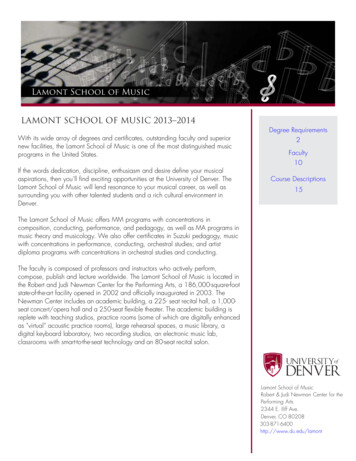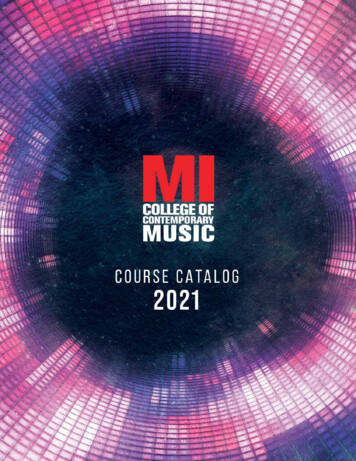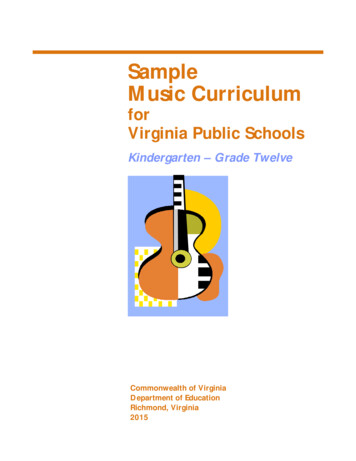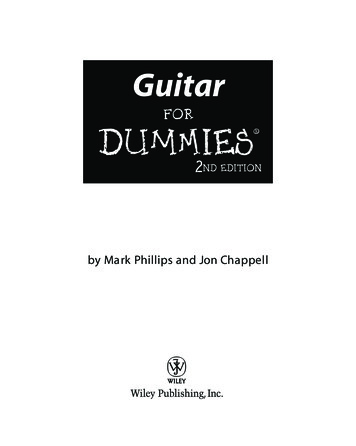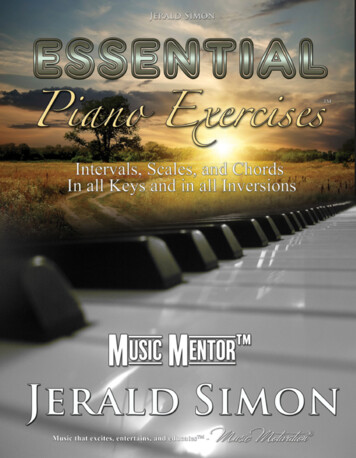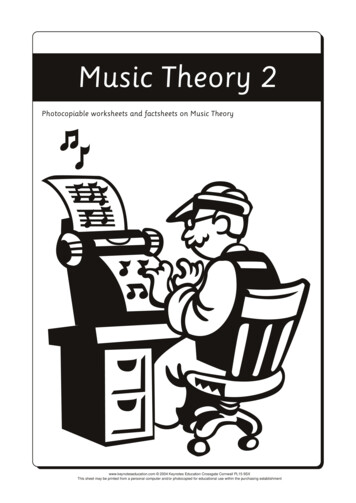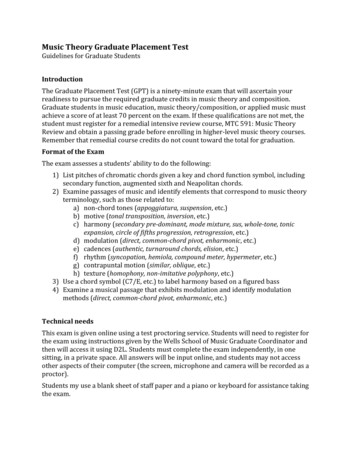
Transcription
Music Theory Graduate Placement TestGuidelines for Graduate StudentsIntroductionThe Graduate Placement Test (GPT) is a ninety-minute exam that will ascertain yourreadiness to pursue the required graduate credits in music theory and composition.Graduate students in music education, music theory/composition, or applied music mustachieve a score of at least 70 percent on the exam. If these qualifications are not met, thestudent must register for a remedial intensive review course, MTC 591: Music TheoryReview and obtain a passing grade before enrolling in higher-level music theory courses.Remember that remedial course credits do not count toward the total for graduation.Format of the ExamThe exam assesses a students’ ability to do the following:1) List pitches of chromatic chords given a key and chord function symbol, includingsecondary function, augmented sixth and Neapolitan chords.2) Examine passages of music and identify elements that correspond to music theoryterminology, such as those related to:a) non-chord tones (appoggiatura, suspension, etc.)b) motive (tonal transposition, inversion, etc.)c) harmony (secondary pre-dominant, mode mixture, sus, whole-tone, tonicexpansion, circle of fifths progression, retrogression, etc.)d) modulation (direct, common-chord pivot, enharmonic, etc.)e) cadences (authentic, turnaround chords, elision, etc.)f) rhythm (syncopation, hemiola, compound meter, hypermeter, etc.)g) contrapuntal motion (similar, oblique, etc.)h) texture (homophony, non-imitative polyphony, etc.)3) Use a chord symbol (C7/E, etc.) to label harmony based on a figured bass4) Examine a musical passage that exhibits modulation and identify modulationmethods (direct, common-chord pivot, enharmonic, etc.)Technical needsThis exam is given online using a test proctoring service. Students will need to register forthe exam using instructions given by the Wells School of Music Graduate Coordinator andthen will access it using D2L. Students must complete the exam independently, in onesitting, in a private space. All answers will be input online, and students may not accessother aspects of their computer (the screen, microphone and camera will be recorded as aproctor).Students my use a blank sheet of staff paper and a piano or keyboard for assistance takingthe exam.
Studying for the ExamToo few entering graduate students review adequately for this exam. Only a smallpercentage pass, and many earn scores in the 40 to 50 percent range. One should begin adetailed review of music theory several weeks before taking the exam, ideally employing atheory textbook such as TONAL HARMONY by Kostka and Payne.If you have any general questions about the placement exam, please contact the chair of theDepartment of Music Theory, History and Composition, Professor Adam Silverman(asilverman@wcupa.edu).Sample QuestionsWriting chromatic chords.1)2)3)Spell V42/ii in F Major, listing the bass tone first.Spell Neap6 in B Minor, listing the bass tone first.Spell Fr 6 in G Minor, listing the bass tone first.TerminologyLocate occurrences in this musical passage that corresponds to each of these terms; audiois online here, beginning at 3 minutes, 16 seconds:https://www.youtube.com/watch?v zyhUHJKfR5Y .4)5)6)7)8)9)10)A secondary pre-dominantA third inversion chordA chromatic neighbor-toneA motive transformed through ornamented transpositionA half cadenceA circle of fifths progressionAn anacrusis
Analysis. Use this musical excerpt to answer questions that follow; audio is online here:https://www.youtube.com/watch?v 6rpb5bZh8js.11)What texture type is exhibited in bars 1-5?a) Hererophonyb) Homophonyc) Non-imitative polyphonyd) Imitative polyphonye) Monophonyf) Imitative monophonyg) Non-imitative polyphony12)What texture type is exhibited in bars 7-13? (use the same choices as above)13)What harmony is found on the downbeat of bar 2 (use a Roman numeral)?14)What harmony is found on the third beat of bar 5 (use a Roman numeral)?15)Locate an instance of a pedal tone.16)Locate one or more appoggiaturas.
Analysis. Use this musical excerpt to answer questions; audio is online here:https://www.youtube.com/watch?v C2Dm2uIenis.17)What type of harmony is prominent?a) Major/minorb) Susc) Octatonicd) Whole-tonee) Meridian18)What term best describes this music’s approach to meter?a) Simpleb) Compoundc) Mixed19)What polyphonic motion type is represented in the left-hand dyads?a) Contraryb) Parallelc) Obliqued) Similar20)Which compositional approaches are evident here?a) Imitative polyphonyb) Ground bassc) Additive rhythmd) Atonalitye) Dodecaphonyf) Whole-toneg) Metric modulation
Modulation. Use this musical excerpt to answer questions; audio is online here:https://www.youtube.com/watch?v XZCZyApl8fQ21)The modulation that occurs between bars 1 and 6 occurs via what technique?a) Direct modulationb) Pivot modulation by common-chordc) Pivot modulation by enharmonic common-chordd) Common-tone modulation22)The modulation that occurs between bars 6 and 8 occurs via what technique? (usethe same choices as above)An answer key is found on the next page
Answer )20)21)22)C (and D, F#, and A in any order)E (and C and G in any order)Eb (and G, A and C# in any order)C#m7(b5)Bm/AA# with the lyric “could” and the D#s in “think of things I’d never thunk”The music over “think of things I’d never thunk before,” as compared to “ocean’snear the shore.”In the last bar of the exampleStarting in the second complete bar on F#m7 through the D chord at the end of thefirst system.The “pick-up” note (D) at the beginningHomophonyImitative polyphonyiv (the F is a non-chord tone)vii 7/ivThe long D beginning in bar 7 is a pedal tone when it is not part of the harmony(bars 9 and 13). The left-hand G in bar 4 is also a pedal tone on the first beat of thebar.The F that begins bar 7, the C that begins bar 8, the G# that begins bar 10 there aremore.OctatonicMixedObliqueAdditive rhythm; atonalityDirect modulationPivot modulation by common-chord
Music Theory Graduate Placement Test Guidelines for Graduate Students Introduction The Graduate Placement Test (GPT) is a ninety-minute exam that will ascertain your . , circle of fifths progression, retrogression, etc.) d) modul


